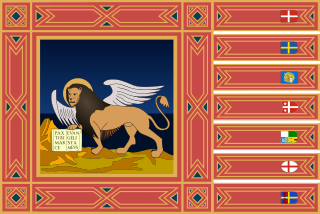
The House of Freedoms was a major centre-right political and electoral alliance in Italy, led by Silvio Berlusconi.

Forza Italia was a centre-right political party in Italy with liberal-conservative, Christian-democratic, liberal, social-democratic and populist tendencies. Its leader was Silvio Berlusconi, who served as Prime Minister of Italy four times.

Democracy is Freedom – The Daisy, commonly known simply as The Daisy, was a centrist political party in Italy. The party was formed from the merger of three parties within the centre-left coalition: the Italian People's Party, The Democrats and Italian Renewal. The party president and leader was Francesco Rutelli, former mayor of Rome and prime ministerial candidate during the 2001 general election for The Olive Tree coalition, within which The Daisy electoral list won 14.5% of the national vote.
Liberalism and radicalism have played a role in the political history of Italy since the country's unification, started in 1861 and largely completed in 1871, and currently influence several leading political parties.

The Christian Democratic Centre was a Christian-democratic political party in Italy from 1994 to 2002. Formed from a right-wing split from Christian Democracy, the party joined the centre-right coalition, and was a member of the European People's Party (EPP).

The Democratic Party of the Left was a democratic-socialist and social-democratic political party in Italy. Founded in February 1991 as the post-communist evolution of the Italian Communist Party, the party was the largest in the Alliance of Progressives and The Olive Tree coalitions. In February 1998, the party merged with minor parties to form Democrats of the Left. At its peak in 1991, the party had a membership of 989,708; by 1998, it was reduced to 613,412.

The Democratic Alliance was a social-liberal political party in Italy.

The 1996 Italian general election was held on 21 April 1996 to elect members of the Chamber of Deputies and the Senate of the Republic. Romano Prodi, leader of the centre-left The Olive Tree, won the election, narrowly defeating Silvio Berlusconi, who led the centre-right Pole for Freedoms.

The Movement for Autonomy is a regionalist and Christian-democratic political party in Italy, based in Sicily. The MpA, whose founder and leader is Raffaele Lombardo, demands economic development, greater autonomy and legislative powers for Sicily and the other regions of southern Italy.

Italian Renewal was a centrist and liberal political party in Italy.

The People of Freedom was a centre-right political party in Italy. The PdL, launched by Silvio Berlusconi on 18 November 2007, was initially a federation of political parties, notably including Forza Italia and National Alliance, which participated as a joint election list in the 2008 general election. The federation was later transformed into a party during a party congress on 27–29 March 2009. The party's leading members included Angelino Alfano, Renato Schifani, Renato Brunetta, Roberto Formigoni, Maurizio Sacconi, Maurizio Gasparri, Mariastella Gelmini, Antonio Martino, Giancarlo Galan, Maurizio Lupi, Gaetano Quagliariello, Daniela Santanchè, Sandro Bondi, and Raffaele Fitto.

The first Prodi government was the 53rd government of Italy. It held office from 18 May 1996 until 21 October 1998.

The Segni Pact, officially called Pact of National Rebirth, was a Christian-democratic, centrist and liberal political party in Italy. The party was founded and named after Mario Segni, a former member of the Christian Democrats who was a prominent promoter of referendums.

The Progressives was a left-wing political alliance of parties in Italy formed in 1994, with relevant predecessors at local level in 1993. The leader of the alliance was Achille Occhetto. The alliance was a predecessor of the modern-day centre-left coalition.

The 1994 Italian general election was held on 27 and 28 March 1994 to elect members of the Chamber of Deputies and the Senate of the Republic for the 12th legislature. Silvio Berlusconi's centre-right coalition won a large majority in the Chamber of Deputies but just missed winning a majority in the Senate. The Italian People's Party, the renamed Christian Democracy (DC), which had dominated Italian politics for almost half a century, was decimated. It took only 29 seats versus 206 for the DC two years earlier—easily the worst defeat a sitting government in Italy has ever suffered, and one of the worst ever suffered by a Western European governing party.

This page gathers the results of elections in Veneto.
The Liberal Democratic Foundation was a Christian-democratic and liberal Italian political party.

The Legislature XII of Italy lasted from 15 April 1994 until 8 May 1996. Its composition was the one resulting from the snap general election of 27 March 1994. The election was called by President Scalfaro, after he dissolved the houses of Parliament on 16 January 1994. This decision was connected to some major events that permanently changed the shape of Italian internal politics during the beginning of the '90s, such as Tangentopoli and the Mafia trials.
The centre-right coalition is an alliance of political parties in Italy, active—under several forms and names—since 1994, when Silvio Berlusconi entered politics and formed his Forza Italia party. Despite its name, the alliance mostly falls on the right-wing of the political spectrum.
The centre-left coalition is an alliance of political parties in Italy active, under several forms and names, since 1995 when The Olive Tree was formed under the leadership of Romano Prodi. The centre-left coalition has ruled the country for more than 15 years between 1996 and 2022.















